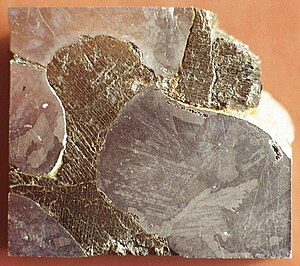Mouth rabilla (meteorite)
Coordinates: 30 ° 47 ′ 0 ″ S , 127 ° 33 ′ 0 ″ E
The Mundrabilla Meteorite is an iron meteorite that fell in the Nullarbor Plain in Western Australia and was still fragmented in the earth's atmosphere . The meteor shower hit probably several million years ago. With a total mass of 24 tons, it is one of the largest meteorite finds in the world.
etymology
The Mundrabilla meteorite is named after the village of Mundrabilla Siding , near which the impacts took place.
Location
Fragments of the Mundrabilla meteorite were found at various locations, but they are all relatively close together at Mundrabilla Siding in the Nullarbor Plain (60 kilometers long and 30 kilometers wide, west-east oriented scattering cone, the meteorite came from the west). The different fragments probably belong to a single bolide that disintegrated by ablation upon entering the earth's atmosphere .
history
The first find of a medium- sized Om octahedrite weighing 112 grams with 0.5 to 1.3 millimeter wide kamacite bands dates back to 1911 . The discoverer was H. Kent, of him as Premier Downs I called. In the same year he found another 116-gram piece 13 kilometers to the west, which he named Premier Downs II . A 99 gram octahedrite, Premier Downs III , was discovered in 1918 . Around 1962 another 108 gram fragment appeared at Loongana Station , found by a Mr. Harrison. In 1965 three more fragments were added, weighing 94.1, 45 and 38.8 grams, which were picked up by WA Crowle 16 kilometers north of Mundrabilla Siding.
However, the findings of the two geologists RB Wilson and AM Cooney in April 1966 were spectacular . In the course of a mapping process, they encountered two huge, matching iron meteorites weighing 9,980 and 5,540 kilograms and only 180 meters apart. They were surrounded by a large number of smaller fragments. The heaviest meteorite got the designation Mundrabilla I . It is the eleventh heaviest meteorite ever discovered (as of 2012) and the heaviest meteorite in Australia. The iron meteorite weighing 9,980 kilograms is now in the Western Australian Museum . A fragment of the meteorite Mundrabilla II was paul ramdohr by one in Adelaide because forming visiting German navy ship with permission of the authorities bring in the 1960s to Germany. The meteorite, which weighs less than 6 tons, was sawed up at the Max Planck Institute in Heidelberg . One disc was sent to Moscow and another to London for further research.
In 1967 , WH Butler dubbed a small straggler weighing 66.5 grams as Loongana Station West .
Two more fragments weighing 1640 kilograms (840 and 800 kilograms) were found by AJ Carlisle in 1979 .
Classification
The Mundrabilla meteorite fragments are middle Om octahedrites and belong to the IAB group of iron meteorites (IAB-ung). Together with the Waterville meteorite they form the Mundrabilla-Duo or Mundrabilla-Grüppchen .
composition

mineralogy
In addition to kamacite ((Fe, Ni)) and taenite ((Fe, Ni)) as the main components, the Mundrabilla meteorite fragments contain troilite inclusions (FeS), plessite as well as graphite (C), writersite ((Fe, Ni, Co) 3 P. ) and Daubréelith (Fe 2+ Cr 3+ 2 S 4 ) as accessories.
Chemical composition
The meteorite is composed of 75% nickel - iron and 25% troilite, an iron sulphide , the troilite being in the form of larger inclusions.
Emergence
Usually, sulfur compounds (like troilite) in asteroids occur in a zone between the inner metallic core and the silicate crust. When the asteroids are formed, the core cools down very slowly and forms crystals. Sulfur-rich compounds that are in liquid form are therefore displaced into the outer areas.
In contrast, the core of the original body of the Mundrabilla meteorite cooled down much faster, so that the sulfur compounds could no longer flow off, but were built into the core. Estimates have shown that the original body cooled by around 500 ° C per year, which is unusually fast.
Paradoxically, the iron-nickel areas of the meteorite have structures that suggest an extremely slow cooling of the core, with about 1 ° in a million years. This was only possible in original bodies that were large enough to protect the core from rapid cooling and in which additional heat was generated due to radioactive decay processes.
Thus, the formation of the Mundrabilla meteorite poses some puzzles, as two opposing mechanisms (rapid cooling of the troilite areas - slow cooling of the nickel-iron zones) came into play.
Age
As early as 1979, Niemeyer was able to determine an age of 4570 ± 60 million years BP on the Mundrabilla meteorite using the argon method . This result represents the highest age of a meteorite to date.
Web links
- nature.com: The Mundrabilla Meteorite: a New Discovery in Western Australia
- SAO / NASA Astrophysics Data System (ADS) - JR de Laeter, WH Cleverly: Further finds from the Mundrabilla meteorite shower
Individual evidence
- ↑ DeLaeter, JR: The Mundrabilla Meteorite Shower . In: Meteoritics . volume 7, number 3, p. 285 .
- ↑ Archived copy ( memento of June 5, 2012 in the Internet Archive ): Meteorite Mystery , in English, accessed on July 7, 2020
- ↑ Wasson, JT and Kallemeyn, GW: The IAB iron-meteorite complex: A group, five subgroups, numerous grouplets, closely related, mainly formed by crystal segregation in rapidly cooling melts . In: Geochimica et Cosmochimica Acta . tape 66 (13) , 2002, pp. 2445-2473 , doi : 10.1016 / S0016-7037 (02) 00848-7 .
- ^ Niemeyer, S .: 40 Ar- 39 Ar dating of inclusions from IAB iron meteorites . In: Geochimica Cosmochimica Acta . tape 43 , 1979, pp. 1829-1840 .



